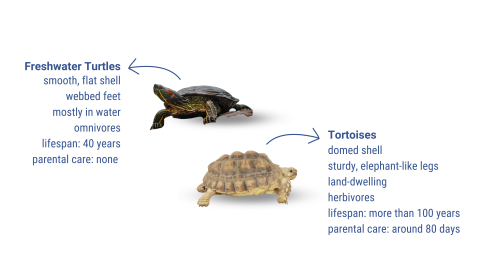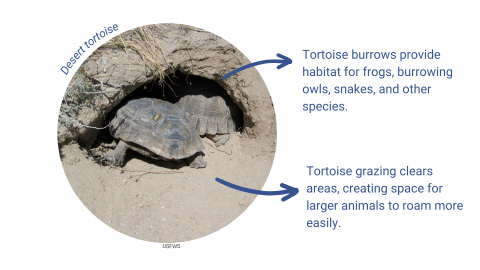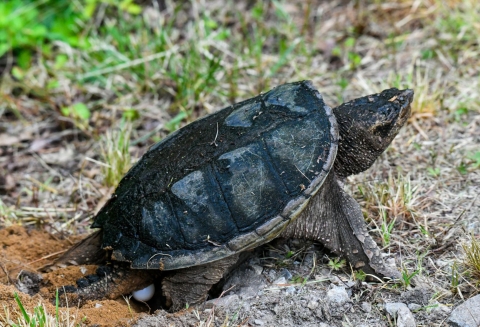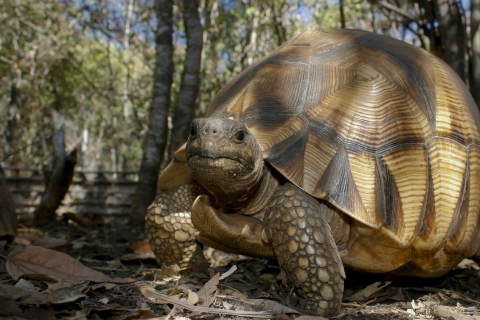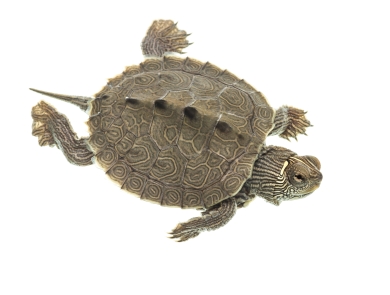What We Do
Our Projects and Initiatives
Through the Tortoise and Freshwater Turtle Conservation Fund, we provide technical and financial assistanceand conservation leadership to protect and recover these important animals.
Tortoises and Freshwater Turtles
There are 357 known tortoise and freshwater turtle species in the world. They are reptiles and from the order Testudines. Their spine is attached to a protective shell, which shields their vital organs from harm. The upper part of the shell is called a carapace; the bottom part is called a plastron. In some species, their head and limbs can move in and out of their shells.
All tortoises are turtles, but not all turtles are tortoises! Confused? Let’s explore some differences between tortoises and freshwater turtles.
The Importance of Healthy Tortoise and Freshwater Turtle Populations
Tortoises and freshwater turtles roamed the earth before humans. In fact, they lived with the dinosaurs more than 220 million years ago and have been revered throughout human history. Depictions of turtles are found in prehistoric carvings, mentioned in religious writings, and featured in stories passed down from generation to generation.
In cultures around the world, turtles represent a variety of common virtuous qualities such as longevity, wisdom, patience, determination, persistence, fertility, peace, tranquility, protection, and transformation. For example, some indigenous tribes believe turtles represent protection and perseverance and there are stories of a turtle diving underwater to deliver mud to make Mother Earth.
The illegal global trafficking is one of the highest threats to a number of turtle species and includes our own native species which are being poached and trafficked at unsustainable numbers. Our work to decrease the demand for turtle species internationally also benefits our at-risk native turtle populations in the United States.
Some tortoises and freshwater turtles can serve as keystone species. This means that other species depend on them to survive, and they are an invaluable asset to their ecosystems and to the health of our planet.
Turtles spread seeds that keep woodlands and riverbanks healthy and contribute to the economic and nutritional needs of local communities. By eating algae, and the organisms that feed on algae, freshwater turtles also help maintain clean waterways and contribute to healthy fish populations supporting local economies.
Some freshwater turtles lay eggs in nests on riverbanks or ponds that can help prevent erosion and reduce flood damage during times of high water. The soil is enriched by them spreading plant seeds and adding in nutrients from their eggshells, which in turn allows for vegetation to grow.
Tortoises and freshwater turtles benefit humans in so many ways. It is up to all of us to protect them to ensure no additional species go extinct.
Threats to Tortoise and Freshwater Turtle Survival
Turtles are found on every continent, except for Antarctica. They are one of the most imperiled animal groups, and more than half face the threat of extinction. It takes years, often decades for turtles to reach reproductive age, so every individual turtle is critical for the survival of future generations.
The major threats to tortoises and turtles include habitat loss and degradation, rising temperatures, predators, bycatch and destructive fishing practices, unsustainable collection, poaching, and wildlife trafficking.
Habitat Loss and Degradation
Tortoise and freshwater turtle species have evolved to survive in habitats ranging from wetlands to deserts. When the natural places they are adapted to become fragmented or disappear entirely, turtles have nowhere else to go. If habitat loss happens across a species’ range, it can lead to extinction. Habitat loss and degradation occurs for multiple reasons, including the construction of new roads, illegal logging, and excessive damming of rivers and lakes.
Rising Temperatures
Temperature changes affect the digestion rate, growth, migration patterns, and the male-to-female ratio of turtles. Warmer nest temperatures result in more female hatchlings, creating a gender imbalance in the population. Additionally, rising water levels can impact access to suitable nest sites and habitat, as well as hatchling survivorship.
Predators
Turtle eggs and hatchlings are often eaten by predators. The introduction of non-native species can cause a much higher predation level on turtles and harm the ecosystem. Human activities including leaving trash or discarded food in turtle habitat can attract more predators to the area creating an ecosystem imbalance.
Bycatch and Destructive Fishing Practices
Incidental capture (bycatch) of freshwater turtles in small-scale commercial fisheries can cause mortality due to entanglement and drowning. High numbers of bycatch can significantly affect freshwater turtle populations causing their decline and even local extinction. Destructive fishing practices are methods of fishing that cause extreme harm to the aquatic habitat on which freshwater turtles depend. These practices disrupt the entire ecosystem and reduce biodiversity including fish populations.
Unsustainable Collection, Poaching, and Wildlife Trafficking
The removal of tortoises and turtles from the wild can impact their entire population. Unsustainable collection is driven by the demand for pets, traditional medicines, and specialty food items. Often when turtles are trafficked, they are packaged in inhumane ways such as taping their limbs, wrapping them in athletic socks, and smuggling them in coffee cans, subject to extreme temperatures without food or water.
When tortoises and turtles are rescued from illegal shipments, it is usually not possible to return them to the wild because their exact origins may be unknown or there is a risk of spreading disease to native reptiles.
Congressional Action
Over the past decades, many turtle population numbers have decreased drastically. Recognizing the ecological value and alarming declines of turtles worldwide, the U.S. Congress established a conservation fund for tortoises and freshwater turtles through the John D. Dingell, Jr. Conservation, Management, and Recreation Act, 2019, Public Law 116-9, which was signed into law on March 12, 2019. Specifically, it expanded the Marine Turtle Conservation Act to include imperiled tortoises and freshwater turtles and provided financial support for projects that conserve populations and habitats of tortoise and freshwater turtles and addressed threats to their survival.
In the Act, Congress wrote:
The purpose of this Act is to assist in the conservation of marine turtles, freshwater turtles, and tortoises and the habitats of marine turtles, freshwater turtles, and tortoises in foreign countries and territories of the United States by supporting and providing financial resources for projects
- to conserve marine turtle, freshwater turtle, and tortoise habitats under the jurisdiction of United States Fish and Wildlife Service programs;
- to conserve marine turtles, freshwater turtles, and tortoises in those habitats; and
- to address other threats to the survival of marine turtles, freshwater turtles, and tortoises, including habitat loss, poaching of turtles or their eggs, and wildlife trafficking.
Conservation Efforts
Administered by our International Affairs program, the Tortoise and Freshwater Turtle Conservation Fund provides technical and financial support to conservation projects outside of the United States. We work closely with partners, including U.S. agencies, other governments (local, regional, and national), non-governmental organizations (NGOs), academia, and communities, to implement a strategic, results-based approach to global tortoise and freshwater turtle conservation. The protection and conservation of tortoises and freshwater turtles is a long-term endeavor. Around the world, conservation organizations, wildlife agencies, volunteers, and many others work hard to conserve these magnificent creatures in the wild.
Specifically, our Tortoise and Freshwater Turtle Conservation Fund supports work to:
Prevent Habitat Loss through restoring and protection
- Identify, protect, and monitor key nesting and foraging sites.
- Encourage regional collaboration to reduce threats to turtle habitat.
- Partner with landowners and local and indigenous communities to restore turtle habitat.
- Develop local capacity for turtle conservation and management.
Combat Wildlife Trafficking
- Promote regional and international networks and partnerships.
- Develop and build capacity at all critical stages of turtle trafficking.
- Reduce demand for illegal turtle products by raising awareness through focused educational campaigns.
- Strengthen turtle conservation through community outreach.
Working with Partners towards Species Recovery
The Tortoise and Freshwater Turtle Conservation Fund is a relatively new Fund. Our long-term goals are to:
- Develop local champions for turtle conservation.
- Strengthen engagement and capacity with local and indigenous communities, local and national NGOs, government authorities, and other relevant stakeholders to promote turtle conservation.
- Empower communities to seek long-lasting solutions to wildlife conservation challenges within their communities.
Notice of Funding Opportunities
Applications for our Notice of Funding Opportunity (NOFO) must be submitted via GrantSolutions.gov.
You can help conserve tortoises and freshwater turtles in multiple ways.
Careers with the U.S. Fish and Wildlife Service
If you would like a career in conservation or volunteer with the U.S. Fish and Wildlife Service, please visit our Careers and Internships web page.

